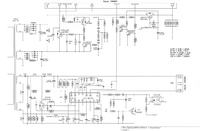Hello.
I have a tv with broken edge lighting. About a week ago I got tired of replacing 9 diodes that went short-circuited in one of four branches of 11 pcs.
Massacre. Somehow I exchanged glad I turned and gave back. A few days, the telephone and TV returned back, this time there are 10 diodes in the other half in the same branch.
Can you see something does not require control?
Now yes? The control is made on SLC5012M which is nice described in the post about the same series but with a larger diagonal. [url=] https://elektroda.pl/rtvforum/topic3178142.html [/url]
I will watch him. For now, the initial inspection and measurements have completely failed. Full symmetry. I will solder the diodes tomorrow and measure the voltage.
However, I am interested in another matter. What is the quickest to pick in such a case, R, L, C, transistors or scalac? You can't see cold solder, cracks, bulges ...
I am asking people with more experience in this direction for any hints.
Thank you and best regards, Piko.
I have a tv with broken edge lighting. About a week ago I got tired of replacing 9 diodes that went short-circuited in one of four branches of 11 pcs.
Massacre. Somehow I exchanged glad I turned and gave back. A few days, the telephone and TV returned back, this time there are 10 diodes in the other half in the same branch.
Can you see something does not require control?
Now yes? The control is made on SLC5012M which is nice described in the post about the same series but with a larger diagonal. [url=] https://elektroda.pl/rtvforum/topic3178142.html [/url]
I will watch him. For now, the initial inspection and measurements have completely failed. Full symmetry. I will solder the diodes tomorrow and measure the voltage.
However, I am interested in another matter. What is the quickest to pick in such a case, R, L, C, transistors or scalac? You can't see cold solder, cracks, bulges ...
I am asking people with more experience in this direction for any hints.
Thank you and best regards, Piko.




